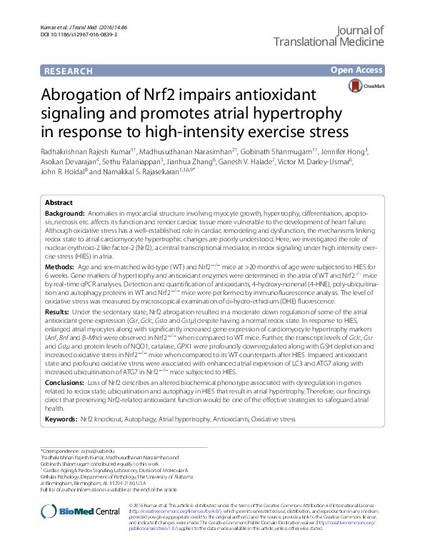
- Antioxidants,
- Atrial hypertrophy,
- Autophagy,
- Nrf2 knockout,
- Oxidative stress
Background: Anomalies in myocardial structure involving myocyte growth, hypertrophy, differentiation, apoptosis, necrosis etc. affects its function and render cardiac tissue more vulnerable to the development of heart failure. Although oxidative stress has a well-established role in cardiac remodeling and dysfunction, the mechanisms linking redox state to atrial cardiomyocyte hypertrophic changes are poorly understood. Here, we investigated the role of nuclear erythroid-2 like factor-2 (Nrf2), a central transcriptional mediator, in redox signaling under high intensity exercise stress (HIES) in atria. Methods: Age and sex-matched wild-type (WT) and Nrf2-/- mice at > 20 months of age were subjected to HIES for 6 weeks. Gene markers of hypertrophy and antioxidant enzymes were determined in the atria of WT and Nrf2-/- mice by real-time qPCR analyses. Detection and quantification of antioxidants, 4-hydroxy-nonenal (4-HNE), poly-ubiquitination and autophagy proteins in WT and Nrf2-/- mice were performed by immunofluorescence analysis. The level of oxidative stress was measured by microscopical examination of di-hydro-ethidium (DHE) fluorescence. Results: Under the sedentary state, Nrf2 abrogation resulted in a moderate down regulation of some of the atrial antioxidant gene expression (Gsr, Gclc, Gstα and Gstμ) despite having a normal redox state. In response to HIES, enlarged atrial myocytes along with significantly increased gene expression of cardiomyocyte hypertrophy markers (Anf, Bnf and β-Mhc) were observed in Nrf2-/- when compared to WT mice. Further, the transcript levels of Gclc, Gsr and Gstμ and protein levels of NQO1, catalase, GPX1 were profoundly downregulated along with GSH depletion and increased oxidative stress in Nrf2-/- mice when compared to its WT counterparts after HIES. Impaired antioxidant state and profound oxidative stress were associated with enhanced atrial expression of LC3 and ATG7 along with increased ubiquitination of ATG7 in Nrf2-/- mice subjected to HIES. Conclusions: Loss of Nrf2 describes an altered biochemical phenotype associated with dysregulation in genes related to redox state, ubiquitination and autophagy in HIES that result in atrial hypertrophy. Therefore, our findings direct that preserving Nrf2-related antioxidant function would be one of the effective strategies to safeguard atrial health.
Journal of Translational Medicine, v. 14, art. 86
Available at: http://works.bepress.com/ganesh-halade/19/